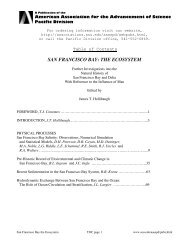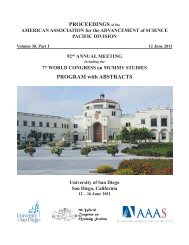Vol 31, Part I - forums.sou.edu ⢠Index page - Southern Oregon ...
Vol 31, Part I - forums.sou.edu ⢠Index page - Southern Oregon ...
Vol 31, Part I - forums.sou.edu ⢠Index page - Southern Oregon ...
You also want an ePaper? Increase the reach of your titles
YUMPU automatically turns print PDFs into web optimized ePapers that Google loves.
ABSTRACTS – Symposia<br />
osteoblasts are affected by changes in inflammtory signaling<br />
and the extracellular matrix and cause changes in turn. This<br />
data may provide insight into processes with relevance to<br />
diverse issues in human health, from cancer to space travel.<br />
18 Going Green in Space KEITH LAMPI (Hydration Technology<br />
Innovations, LLC, Vice President of Operations, 2484<br />
Ferry St. SW, Albany, OR 97322; klampi@htiwater.com).<br />
Hydration Technology Innovations has worked with NASA<br />
for 15 years providing materials and research for life support<br />
systems focusing on water reuse. The brief talk will relay these<br />
findings and discuss technology transfer for both industrial and<br />
humanitarian opportunities and conclude with the results of<br />
testing of an emergency hydration pouch by Commander Chris<br />
Ferguson on the Space Shuttle Atlantis (STS 135).<br />
19 Calcium Flux During Cell-Cell Communication – BSU<br />
Microgravity University 2012, REILLY CLARK, Lindsey<br />
CATLIN*, Landon Nye, Kellen MATHER,<br />
TRAVIS Baker, DAVID CONNOLLY, MATTHEW<br />
Dolan, Jason Archer, EUGENE CASTRO,<br />
Audra Phelps, Nic baughman, Daniel Lambert,<br />
Marie Tharp, Joshua Anghel, Benjamin<br />
DAVIS, ROBERT HAY, ALARK JOSHI, Sarah<br />
haight, elisa Barney smith, Julia Oxford,<br />
and BARBARA MORGAN (Department of Biological<br />
Sciences, Department of Electrical and Computer Engineering,<br />
Department of Mathematics, Department of Mechanical<br />
and Biomedical Engineering, Department of Business<br />
Management, Department of Computer Science, Division<br />
of Research, Boise State University, Boise, ID 83725;<br />
reillyclark@u.boisestate.<strong>edu</strong>)<br />
Osteocytes integrate mechanical information into chemical<br />
signals relayed to osteoclast and osteoblast cell populations.<br />
In effect, these signals orchestrate bone resorption and<br />
formation by the osteoclasts and osteoblasts, respectively.<br />
While these activities are essential for the maintenance of<br />
healthy bone, imbalances in these processes by exposure to<br />
extreme environments, such as microgravity, are hypothesized<br />
to lead to highly detrimental bone loss. Changes in<br />
free calcium concentration, known as calcium flux, is an<br />
intermediate step in the chemical signaling processes of the<br />
osteoctyes. To determine how environments of continually<br />
alternating forces affect the bones of the human body, it is<br />
important to study how those environments affect calcium<br />
flux. To this end, this experiment examined how osteocyte<br />
and osteoblast mono- and co-cultures respond to the periods<br />
of micro-and hyper-gravity experienced onboard NASA’s<br />
Weightless Wonder. Calcium flux in the three cell cultures<br />
was fluorescently monitored through the use of a lens and<br />
imaging-based system. The cellular calcium concentrations<br />
increased during periods of hyper-gravity and decreased during<br />
periods of microgravity.<br />
20 Device Design and Development for Imaging Cellular<br />
Behavior – BSU Microgravity University 2012, DAVID<br />
CONNOLLY, MATTHEW Dolan*, Jason Archer,<br />
EUGENE CASTRO, REILLY CLARK, Kellen<br />
MATHER, Lindsey CATLIN, Landon Nye, Travis<br />
Baker, Audra Phelps, Nic Baughman,<br />
Daniel LAMBERT, Marie Tharp, Joshua Anghel,<br />
Benjamin DAVIS, Alark Joshi, ROBERT<br />
Hay, Sarah haight, elisa Barney smith,<br />
BARBARA MORGAN, and Julia Oxford (Department<br />
of Electrical and Computer Engineering, Department<br />
of Mechanical and Biomedical Engineering, Department of<br />
Computer Science, Department of Business Management,<br />
Department of Mathematics, Department of Biological Sciences,<br />
Division of Research, Boise State University, Boise,<br />
ID 83725; davidconnolly@u.boisestate.<strong>edu</strong>).<br />
This year’s Boise State Microgravity University team is<br />
building a system which excites osteocyte mono-cultures and<br />
osteocyte-osteoblast co-cultures at 350nm and then images<br />
the Indo-1 dye at 485nm and 405nm based on whether<br />
the dye is unbound or bound to calcium, respectively. In<br />
order to image these wavelengths, the system built needed<br />
enough resolution to image 96 5mm wells in a 3x5 inch 96<br />
well microtiter plate. Another complexity of the system is<br />
that it needed to image these wells during a 30s period of<br />
micro or hyper gravity, requiring the exposure time and time<br />
between captures to be small. The imager itself needed to be<br />
sensitive enough that it can capture the wavelengths without<br />
introducing unnecessary noise even though the signal does<br />
not have significant luminosity. Two mono-chrome imagers<br />
using C-mount band-pass filters were used in order to isolate<br />
the 405nm and 485nm emissions simultaneously. Capturing<br />
images was done using Aptina proprietary software and C<br />
programming language utilizing multi-threading to capture<br />
images from both cameras simultaneously. After capturing<br />
the RAW images, the edges of each cell were detected, and<br />
the contents were analyzed to determine how much luminosity<br />
from each well was caused by unbound or bound dye,<br />
allowing a quantification of free calcium.<br />
Forensic Psychology in Evaluating<br />
a Lone Wolf Terrorist: An Analysis of<br />
the Norway Killer<br />
Monday, 8:40 a.m. in PAYETTE RIVER<br />
21 Overview and Questions for Forensic Psychology in Homegrown<br />
Lone Wolf Terrorism Cases, RONN JOHNSON (Clinical<br />
Mental Health Program, University of San Diego, 5998<br />
Alcalá Park, San Diego, CA, 92110; ronnjohn@sandiego.<strong>edu</strong>).<br />
Police and public safety personnel often make decisions<br />
designed to protect citizens. These decisions are frequently<br />
made with a degree of uncertainty when it comes to acts of<br />
terror. Nonetheless, clinical mental health professionals are<br />
52








